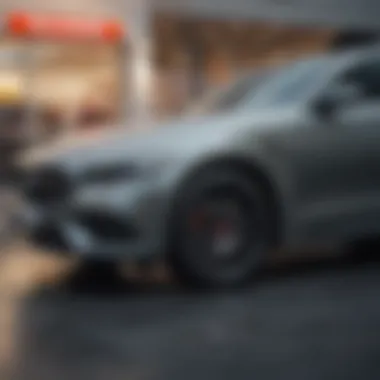Comprehensive Guide to Automotive Window Films


Intro
Window film options available at AutoZone represent an intriguing blend of functionality and aesthetics for automotive enthusiasts and everyday drivers alike. The right window film can enhance a vehicle's appearance while addressing practical concerns such as UV protection and heat rejection. This article provides a thorough examination of these options, their features, and pertinent factors to consider during the installation process. The landscape of window films is vast, with various products designed to meet specific needs and preferences.
Choosing the appropriate window film requires understanding the specifications and benefits of each type. Moreover, it is crucial to comprehend the implications of legal regulations regarding window tinting that vary by region. AutoZone stands out as a reliable provider of these films, offering accessible purchasing options and a guide tailored to different vehicle types. Maintenance and technological trends in window films further enrich this discussion, ensuring a well-rounded insight into these automotive enhancements.
Understanding Window Films
Window films serve multiple purposes, making them a significant consideration for vehicle owners. Understanding their characteristics is important when deciding on options for automotive use. The right window film can enhance the appearance of a vehicle, provide protection from harmful UV rays, increase comfort by reducing heat inside the car, and improve privacy. As such, having a thorough understanding of window films will equip readers with the knowledge to choose the best option for their specific needs.
Definition and Purpose
Window films are thin layers of material attached to a vehicle's windows. Their primary purpose is to modify sunlight entering the vehicle, which impacts heat levels and visibility. They come in various shades and functionalities, catering to both aesthetic desires and practical needs. Many drivers seek window films to increase comfort during hot weather or to provide a more cohesive look for their vehicles.
Types of Window Films
Understanding the different types of window films available is crucial for making an informed choice. Each variant offers unique characteristics, thereby serving different needs and preferences. Below are the main types available:
Dyed Window Film
Dyed window film is among the most common options available. This type uses a layer of dye, which absorbs heat and reduces glare. One of the main characteristics of dyed film is its affordability. This makes it a popular choice among those looking for budget-friendly options. However, while it does provide some UV protection and heat reduction, dyed films may fade over time and do not offer as much durability as other options.
Metalized Window Film
Metalized window film contains metal particles that reflect heat and UV rays. Its key characteristic is its ability to enhance the strength of the glass, providing additional protection in case of shattering. Metalized films are an effective choice for those wanting significant heat rejection properties. However, they may interfere with GPS and cellular reception, which is a notable disadvantage.
Carbon Window Film
Carbon window film brings a balance of performance and aesthetics. It offers excellent heat rejection without the reflective appearance of metalized films. The unique feature of carbon films is their ability to maintain a stylish look while providing protection against UV rays. This variety does not fade over time, making it a durable option. Nevertheless, it may be priced higher than dyed films, potentially posing a budget consideration for some buyers.
Ceramic Window Film
Ceramic window film represents advanced technology in window film options. This type uses nanotechnology to enhance its functionality. Its key attributes are superior heat rejection and UV protection while maintaining clarity and aesthetic appeal. Ceramic films do not interfere with electronic devices as metalized options can. However, they are typically the most expensive choice, which may not suit everyone's budget.
Key Benefits of Window Films
When discussing window films, the conversation often turns to their benefits. Understanding these advantages can further reinforce the value of window films.
UV Protection
One of the standout features of window films is their ability to block harmful ultraviolet (UV) rays. UV protection is essential for preserving both the interior of vehicles and the health of passengers. Continuous exposure to UV radiation can lead to skin damage and fading of interiors. Thus, choosing a window film with strong UV protection can safeguard passengers and extend the life of car interiors.
Heat Rejection
Another primary advantage of window films is heat rejection. They can dramatically reduce the interior temperatures of vehicles on hot days. This creates a more comfortable driving environment and reduces the necessity for air conditioning, consequently improving fuel efficiency. Choosing films with high heat rejection can prove beneficial in regions with hot climates.
Enhanced Privacy
Enhanced privacy is a significant concern for many car owners. Tinted window films provide varying levels of opacity, allowing drivers to maintain discretion while keeping the interior of their vehicles out of view. This feature not only adds a layer of security but also protects passengers from onlookers. Car owners must assess their needs for privacy when selecting window films.
Aesthetic Improvement
Lastly, aesthetic improvement is often a key motivating factor behind the choice of window films. They can offer a sleek and modern look to vehicles. The available shades and finishes help to personalize vehicles, which many owners appreciate. However, it is important to choose wisely, as overly dark films can detract from visibility and potentially violate local regulations.
Window Film Options at AutoZone
Window films serve multiple purposes, enhancing the functionality and appearance of vehicles. At AutoZone, a broad selection of window films caters to various needs, from UV exposure protection to aesthetic improvements. Understanding the available options, their quality considerations, and pricing is vital for making informed choices.
Available Products
Pre-cut Window Films
Pre-cut window films provide convenience, allowing for easy installation without the need for complex cutting. These films are specifically designed to fit various vehicle models, ensuring a cleaner and more professional look. The main characteristic of pre-cut films is their user-friendly design, making them popular among those looking for hassle-free installation. However, some users may find the limited selection of tint options restrictive.


Rolls of Window Tint
Rolls of window tint offer flexibility in coverage and application. Unlike pre-cut options, these rolls can be cut to fit any window size. This versatility is particularly beneficial for custom vehicle designs or unique window shapes. The key feature of roll films is their ability to provide a personalized installation experience. On the downside, they often require more skill and experience to install than pre-cut films.
Specialty Films
Specialty films include unique features aimed at specific needs, such as heat resistance or privacy enhancement. These films may have additional coatings for better durability or aesthetic appeal. Specialty films are valuable for those seeking functional enhancements beyond basic tinting. However, they may come at a higher price and require careful consideration regarding the specific needs of a vehicle.
Quality Considerations
Material Quality
The quality of materials used in window films significantly affects their performance and longevity. High-quality films resist fading and bubbling over time, providing lasting protection. Users benefit from investing in films made from premium materials that claim better durability. Lower quality films might save initial costs but could lead to greater expenses due to replacements.
Brand Reputation
Brand reputation plays a role in the decision-making process when selecting window films. Established brands often provide reliable products with better customer support and warranties. It is essential to consider brands known for their commitment to quality and customer satisfaction. Lesser-known brands may offer lower prices but might lack the same level of assurance on quality and durability.
Warranty Information
Warranty details offer insight into the manufacturer's confidence in their products. A good warranty reflects a brand's belief in the durability and effectiveness of its films. It also provides a safety net for consumers should any issues arise. Films without solid warranty options might pose risks for customers, as replacements or remedies could become more expensive in the long run.
Price Range
Budget Options
Budget window film options help consumers enhance their vehicles without significant investment. These are ideal for drivers who want basic protection or aesthetic improvements without breaking the bank. The main feature of budget options is affordability; however, they may offer reduced longevity and performance compared to pricier selections.
Mid-range Selections
Mid-range selections balance quality with affordability. They usually provide decent performance and durability while remaining accessible to many consumers. These selections often come with better material quality than budget options and might include some warranty coverage. This combination makes them a popular choice among a variety of drivers.
Premium Choices
Premium window films provide the highest level of protection, often built with advanced technology to provide enhanced durability and performance. Consumers often appreciate these films for their aesthetic appeal and long-term value. However, the cost can be considerably higher, which might deter some buyers. Investing in premium choices typically results in fewer issues and a longer-lasting solution.
Purchasing Window Films at AutoZone
The act of purchasing window films at AutoZone is a vital consideration for car owners who want to improve the functionality and aesthetics of their vehicles. Understanding the available options can help buyers make informed decisions. A clear outline of product availability, quality considerations, and price range contributes significantly to a more focused and satisfying shopping experience. Knowing what to look for when buying window films allows customers to avoid pitfalls and find exactly what fits their needs.
Store Locations and Online Availability
AutoZone has numerous physical locations across the country. This advantage allows customers to visit and examine window films in person. Seeing the products helps in assessing quality and evaluating color options.
For those who prefer online shopping, AutoZone provides a robust website. Customers can browse through various films before making a purchase. Online shopping adds convenience, especially for those whose schedules may not align with store hours. Similarly, the website offers detailed product information, enhancing decision-making.
Comparing Products Online
User Reviews
User reviews play an important role in the online purchasing process. They provide insights that are not listed in product descriptions. Reviews often reflect real-world use, giving potential buyers a clearer picture of what to expect. This transparency can influence customer choices significantly.
The key characteristic of user reviews is their credibility. Many consumers tend to trust opinions from fellow buyers over traditional marketing messages. An abundance of positive feedback can establish a product’s reputation and encourage purchase. Conversely, negative reviews can highlight potential issues, serving as warning signs.
However, one disadvantage of relying too much on user reviews is their subjectivity. Some reviews may be biased or influenced by factors unrelated to the product itself.
Product Specifications
Product specifications are crucial for understanding window films' capabilities and limitations. They provide a detailed breakdown of the materials, thickness, light transmission, and UV blocking percentages. By examining these factors, customers can assess how well a particular film matches their preferences and needs.
The key feature of product specifications is their focus on functionality. Knowing the precise characteristics of a film can help predict its performance over time. This information assists in selecting films that will offer proper UV protection and heat rejection, aligning with the customer's goals.
On the downside, technical specifications can be overwhelming for inexperienced buyers. They may need time to interpret details correctly, which could lead to confusion.
Customer Support


Installation Assistance
Installation assistance is an invaluable service offered by AutoZone. For customers who choose not to install window films themselves, seeking help can ensure a more professional result. AutoZone often provides resources, including guides or references to local installers. This support contributes to overall customer satisfaction.
A key feature of installation assistance is the expertise it brings to the process. Experienced professionals may offer techniques and tips that a novice may overlook.
However, relying entirely on assistance can also lead to additional costs. Finding a trustworthy installer is essential, or else customers may face disappointing quality.
Return Policies
Return policies represent another fundamental aspect of the purchasing process at AutoZone. A clear return policy can provide a sense of security for customers. If a window film does not meet expectations, the option to return it alleviates buyer's remorse.
The key characteristic of return policies is their clarity. Customers should understand the timeframe and conditions required for returns. This transparency promotes confidence in the purchase process.
Nonetheless, return policies may vary by product and can sometimes seem restrictive. Customers must read the details carefully to avoid surprises when trying to return an item.
In summary, navigating the purchasing process for window films at AutoZone requires knowledge of store locations, product comparison, customer support, and understanding return policies. This foundational information is crucial for making informed decisions.
Installation of Window Films
A proper installation of window films is a crucial aspect of enhancing automotive aesthetics and functionality. The method chosen can significantly influence the film’s performance and lifespan. Understanding the nuances of installation, whether professional or DIY, is important for ensuring the desired results. Different methods yield different outcomes, and several factors, such as budget, skill level, and time commitment, determine which option is best for each individual.
Professional vs. DIY Installation
When deciding between professional installation and doing it yourself, consider several critical factors. Professionals typically offer expertise that ensures a flawless finish. Their experience ensures that the installation adheres to local laws and regulations on tinting. On the other hand, DIY installation can be cost-effective and offers a sense of accomplishment for those who enjoy hands-on projects. However, without proper technique, the outcome may be less satisfactory, leading to potential reinstallation costs.
Basic Installation Process
Pre-preparation Steps
Pre-preparation steps are foundational to a successful installation. Cleaning the windows thoroughly is key to achieving a bubble-free application. It is common to use a mixture of water and mild soap for this. Additionally, gathering necessary tools in advance—like a squeegee, utility knife, and heat gun—will streamline the process. Preparing well can make the entire installation experience more efficient and enjoyable.
One significant characteristic of these steps is the requirement to work in a controlled environment. Dust and debris can easily ruin the look of the window film, making pre-preparation even more vital.
Application Techniques
Application techniques are major determinants of the final appearance of window films. Techniques such as the ‘wet method’ involve applying a light film of water on the window, allowing for repositioning. This method is favored as it reduces the likelihood of bubbles during application. Conversely, the ‘dry method’ offers speed but requires precision. The advantage of knowing which technique suits your skill level can help ensure a better finished product.
Finishing Touches
Finishing touches play a considerable role in the overall outcome. After applying the window film, the edges need to be trimmed and excess material removed. Adjusting the tint for even application is standard at this stage. This ensures the film adheres completely and performs well over time. Attention to detail during these final steps enhances both appearance and effectiveness. This aspect could make or break the entire installation experience.
Common Installation Mistakes
Being aware of common installation mistakes can save time and resources. One frequent error is inadequate cleaning, leading to bubbles and imperfections. Another common issue is not allowing the film to acclimate before installation, which can affect adhesion. Improper cutting of the film can also result in uneven edges and an unprofessional look. Being attentive to these potential pitfalls can greatly improve the overall installation experience.
Maintaining Window Films
Proper maintenance of window films is crucial for preserving their appearance, effectiveness, and longevity. Automotive films can enhance a vehicle's aesthetics and provide practical benefits such as UV protection, but neglect can lead to a range of issues that detract from their value.
Regular maintenance ensures that window films continue to perform as intended and remain visually pleasing. This involves routine cleaning and being vigilant for signs of damage. Ignoring this maintenance can lead to reduced functionality and increased repair costs in the long run.
Cleaning Techniques
Recommended Cleaning Products
When selecting cleaning products for window films, it is important to choose those that are non-abrasive and free from ammonia. These products are gentle enough to clean the surface without damaging the film. Many car enthusiasts prefer specialized cleaners like Film Guard or Invisible Glass, which are particularly formulated for tinted windows.
The key characteristic of these cleaning products lies in their ability to effectively remove dirt and grime without interfering with the film's adhesive properties. Their unique formulations reduce the risk of streaking or scratching, making them a popular choice among users. However, it is essential to avoid harsh chemicals that may react negatively with the film, leading to discoloration or peeling over time.
Frequency of Cleaning
Establishing a cleaning routine is vital for maintaining window films. It is advisable to clean the windows every few weeks, or as often as necessary to remove accumulated dirt. In areas with more dust or pollution, increasing the frequency makes sense. This consistent upkeep can prevent the build-up of grime that might otherwise lead to scratches or damage.


The benefit of having a set cleaning schedule is that it simplifies the process, reducing the chance of forgetting this valuable maintenance task. Regular cleaning can prolong the film's life and ensure that it remains visually appealing. Over time, some might find that their films look fresher and clearer due to this maintained effort.
Signs of Damage
Recognizing signs of damage is essential for maintaining the integrity of window films. Prompt action can prevent minor issues from escalating into major problems.
Bubbles
Bubbles are a common issue that can arise after installation or from temperature fluctuations. They indicate that air has become trapped between the window and the film. This can diminish both the aesthetic quality and functionality of the film.
Addressing bubbles without delay is beneficial. They can sometimes be pushed out with a soft cloth or by using a vacuum. However, if left unattended, bubbles can lead to peeling and further damage.
Peeling
Peeling is another sign of potential trouble. This occurs when the edges of the window film begin to lift away from the glass surface. The key characteristic of peeling is that it compromises the film’s ability to offer UV and heat protection. This issue can appear as a result of poor installation or poor-quality adhesive.
Acting quickly can mitigate this problem. In some cases, reapplying adhesive can resolve the situation, but often replacement may be necessary. It is crucial to monitor for this sign to maintain the effectiveness of the window film.
Discoloration
Discoloration can manifest as fading or changes in color over time. This sign often results from prolonged exposure to sunlight, particularly with films that are not of high quality. The uniqueness of this issue lies in its gradual nature, making it less noticeable at first but ultimately damaging.
If discoloration is observed, it could affect the film's performance in terms of UV protection. Understanding this risk can prompt timely replacement, ensuring that the vehicle maintains its protective features.
Regular maintenance of window films, including consistent cleaning and immediate attention to damage signs, can significantly extend the lifespan and effectiveness of the film.
Legal Considerations
Understanding the legal implications of window film application is crucial for vehicle owners. Laws surrounding window tinting vary by state, often defining how dark or reflective window films can be, and establishing specific guidelines. Ignorance of these regulations can lead to unnecessary legal troubles and financial penalties.
Window Tinting Laws
State Regulations
State regulations significantly affect how window films can be used on vehicles. Each state has its own set of rules determining the darkness and reflectivity allowed for various windows, including the front windshield, driver, and passenger windows, as well as rear windows.
In some states, for example, front windshields must remain clear, whereas, in others, specific tint percentages are permissible. This not only ensures that vehicles comply with safety standards but also protects the driver and passengers.
A key characteristic of state regulations is their variability. While some states may have lenient laws allowing darker tints, others impose stricter limits. This inconsistency is both a challenge and a benefit for car owners. It can provide flexibility in regions with fewer restrictions but may also mean that what is legal in one state could be illegal in another. Therefore, understanding and adhering to these regulations is essential to avoid violations.
Visibility Requirements
Visibility requirements are another critical component of window tinting laws. These guidelines set minimum standards for light transmission through tinted windows, ensuring that drivers can see adequately. The regulations determine the maximum tint percentages allowed, safeguarding against overly dark windows that can obstruct visibility and potentially cause accidents.
A significant feature of visibility requirements is their universal importance—they are typically enforced in all states, emphasizing safety as a paramount concern. Meeting these requirements is essential for anyone who wishes to maintain compliance and avoid potential legal penalties. The downside is that this often limits personalization of window films, which some car enthusiasts might find restrictive.
Consequences of Violating Tint Laws
Violating tint laws can have serious consequences. These penalties vary significantly based on the location and severity of the violation. Common repercussions include fines, mandatory removal of illegal window films, and, in some cases, vehicle inspections. Regular checks may be performed by law enforcement, particularly during traffic stops.
Additionally, a vehicle that is not compliant with tinting regulations may fail state inspections, potentially leading to increased insurance premiums. In extreme cases, repeat offenders could face escalating fines, creating a financial burden that outweighs any benefits gained from non-compliance.
"Understanding and adhering to window tinting laws is crucial for a smooth driving experience. Ignorance can lead to penalties that impact both safety and finances."
In summary, being well-informed about legal considerations surrounding window films is an essential aspect of vehicle modification. This knowledge not only helps in making legal choices about window tint but also enhances overall vehicle safety.
Emerging Trends in Window Film Technology
Understanding the emerging trends in window film technology is crucial, especially for those making informed decisions about their vehicle’s aesthetics and protection. This segment introduces recent innovations and shifting consumer preferences, reflecting how window film options evolve to meet diverse needs.
Advancements in Film Composition
Recent advancements in film composition focus on enhancing performance and durability. Manufacturers now use improved materials that offer better heat rejection and UV protection. Notably, films often incorporate micro-thin layers of metal oxides, which enable effective thermal insulation without compromising visibility. The result is smarter materials that adjust to temperature, ensuring a cooler cabin during hot weather.
Furthermore, today's films are designed to resist fading and discoloration. This is essential for maintaining a vehicle's appearance over time. As consumers lean toward more sustainable products, many brands now prioritize eco-friendly materials. This shift not only caters to environmental concerns but also enhances performance, making these films a smart choice for eco-conscious drivers.
Increased Customization Options
Customization options have expanded significantly, reflecting consumer desires for unique vehicle aesthetics. Modern window films come in various shades, patterns, and finishes, allowing drivers to personalize their car's look. From subtle tints to bold designs, consumers can choose films that align with their style.
Moreover, some brands offer bespoke film solutions, letting customers create custom graphics. This capability appeals to those looking to express individuality through their vehicles. Not only do these films improve appearance, but they also allow for enhanced privacy. As a result, drivers can enjoy a personalized driving experience while benefiting from the core advantages of window films, such as UV protection and heat rejection.
“Innovative window films not only provide practical benefits but also reflect personal style.”
In summary, the advancements in film composition and increased customization options signify substantial progress in window film technology. These trends encourage informed decisions for consumers at AutoZone, fostering a deeper connection between vehicle owners and their cars. As such, understanding these developments is essential to selecting the most suitable window films, ultimately enhancing both functionality and aesthetic appeal.















